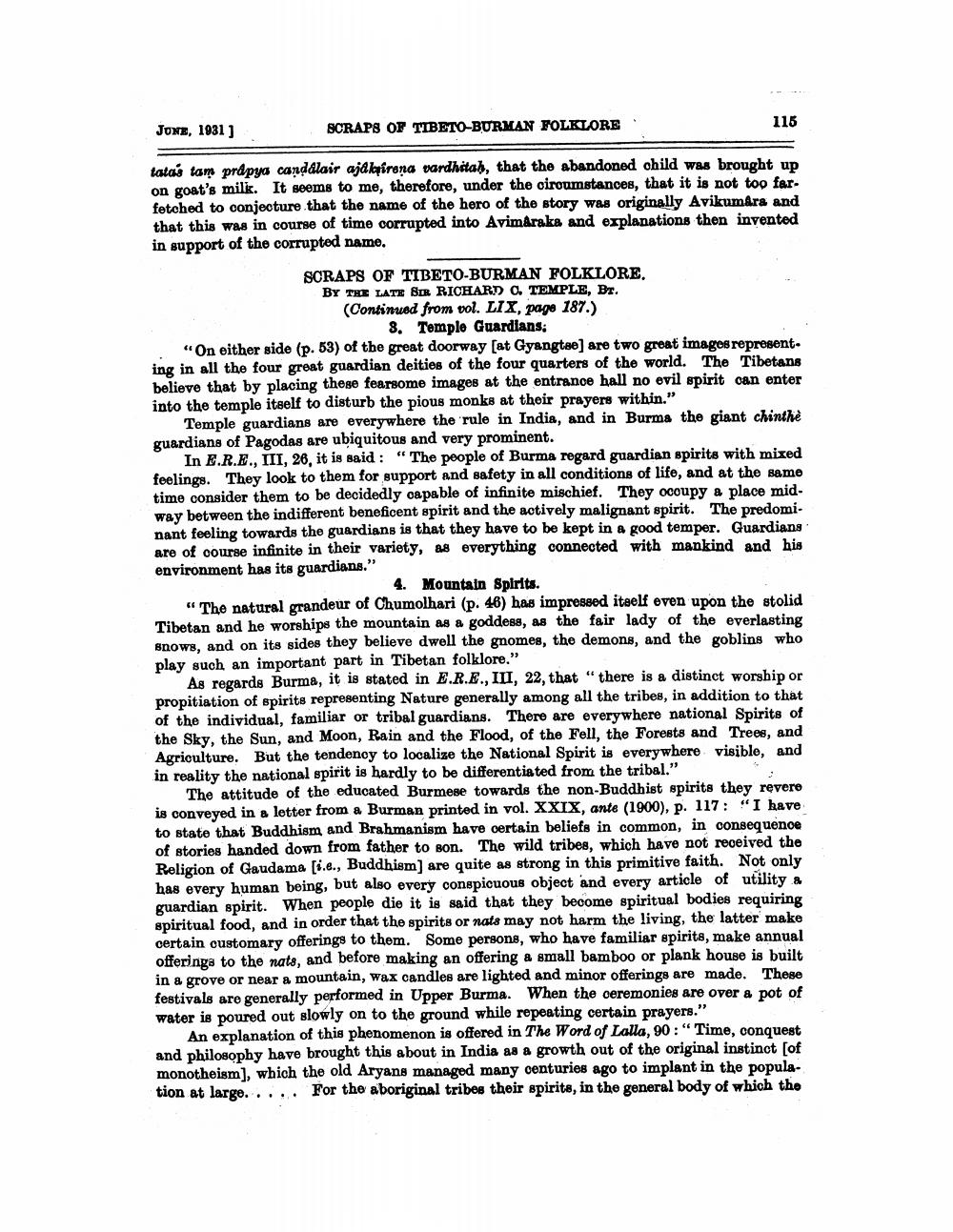________________
Jona, 1931
SCRAPS OF TIBETO-BURMAN FOLKLORE
115
tatas tam prapya candAlair ajdlqirona vardhiah, that the abandoned child was brought up on goat's milk. It seems to me, therefore, under the ciroumstances, that it is not too far. fetched to conjecture that the name of the hero of the story was originally Avikumara and that this was in course of time corrupted into Avimaraka and explanations then invented in support of the corrupted name.
SCRAPS OF TIBETO-BURMAN FOLKLORE, BY THE LATE SIR RICHARD O. TEMPLE, Br. (Continued from vol. LIX, page 187.)
8. Temple Guardians; "On either side (p. 53) of the great doorway [at Gyangtae) are two great images represent. ing in all the four great guardian deities of the four quarters of the world. The Tibetans believe that by placing these fearsome images at the entrance hall no evil spirit can enter into the temple itself to disturb the pious monks at their prayers within."
Temple guardians are everywhere the rule in India, and in Burma the giant chinthe guardians of Pagodas are ubiquitous and very prominent.
In E.R.E., III, 26, it is said: "The people of Burma regard guardian spirits with mixed feelings. They look to them for support and safety in all conditions of life, and at the same time consider them to be decidedly capable of infinite mischief. They ocoupy a place midway between the indifferent beneficent spirit and the actively malignant spirit. The predomi. nant feeling towards the guardians is that they have to be kept in a good temper. Guardians are of course infinite in their variety, 28 everything connected with mankind and his environment has its guardians."
4. Mountain Spirits. " The natural grandeur of Chumolhari (p. 46) bas impressed itself even upon the stolid Tibetan and he worships the mountain as a goddess, as the fair lady of the everlasting snows, and on its sides they believe dwell the gnomes, the demons, and the goblins who play such an important part in Tibetan folklore."
As regards Burma, it is stated in E.R.E., III, 22, that "there is a distinct worship or propitiation of spirits representing Nature generally among all the tribes, in addition to that of the individual, familiar or tribal guardians. There are everywhere national Spirits of the Sky, the Sun, and Moon, Rain and the Flood, of the Fell, the Forests and Trees, and Agriculture. But the tendency to localize the National Spirit is everywhere visible, and in reality the national spirit is hardly to be differentiated from the tribal."
The attitude of the educated Burmese towards the non-Buddhist spirits they revere is conveyed in a letter from a Burman printed in vol. XXIX, ante (1900), p. 117: "I have to state that Buddhism and Brahmanism have certain beliefs in common, in consequence of stories handed down from father to son. The wild tribes, which have not received the Religion of Gaudama [i.e., Buddhism) are quite as strong in this primitive faith. Not only has every human being, but also every conspicuous object and every article of utility & guardian spirit. When people die it is said that they become spiritual bodies requiring spiritual food, and in order that the spirits or nats may not harm the living, the latter make certain customary offerings to them. Some persons, who have familiar spirits, make annual offeringa to the nats, and before making an offering a small bamboo or plank house is built in a grove or near a mountain, Wax candles are lighted and minor offerings are made. These festivals are generally performed in Upper Burma. When the ceremonies are over a pot of water is poured out slowly on to the ground while repeating certain prayers."
An explanation of this phenomenon is offered in The Word of Lalla, 90: “Time, conquest and philosophy have brought this about in India as a growth out of the original instinct [of monotheism), which the old Aryans managed many centuries ago to implant in the population at large...... For the aboriginal tribes their spirits, in the general body of which the




